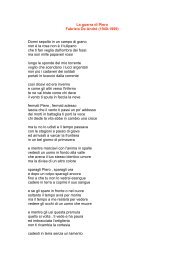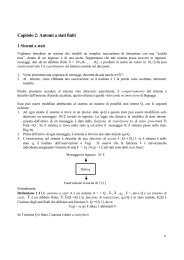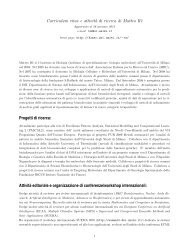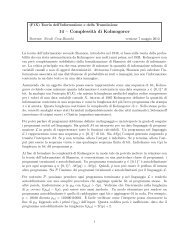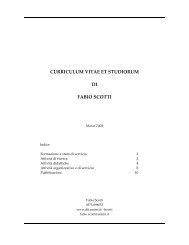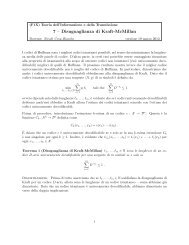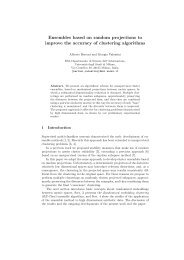La formula di Eulero (1765) - Binet (1843) ricavata elementarmente
La formula di Eulero (1765) - Binet (1843) ricavata elementarmente
La formula di Eulero (1765) - Binet (1843) ricavata elementarmente
You also want an ePaper? Increase the reach of your titles
YUMPU automatically turns print PDFs into web optimized ePapers that Google loves.
<strong>La</strong> <strong>formula</strong> <strong>di</strong> <strong>Eulero</strong> (<strong>1765</strong>) - <strong>Binet</strong> (<strong>1843</strong>) <strong>ricavata</strong> <strong>elementarmente</strong><br />
Partiamo dalla definizione dei numeri <strong>di</strong> Fibonacci<br />
f(0) = 0, f(1) = 1, f(n) = f(n – 1) + f(n – 2) per n > 1. (*)<br />
1) f(n) = f(n – 1) + f(n – 2) ≤ 2 f(n – 1) per n abbastanza grande<br />
(<strong>di</strong> fatto, per n > 1): il metodo iterativo ci dà quin<strong>di</strong><br />
f(n) ≤ 2 f(n – 1) ≤ 2 · 2 · f(n – 2) ≤ … ≤ 2 k f(n – k) ≤ … ≤ 2 n-1 f(1),<br />
ovvero f(n) = O(2 n ).<br />
2) Ma non può essere f(n) = c · 2 n , perché c · 2 n = c · 2 n-1 + c · 2 n-2 =<br />
3 c · 2 n-2 dà 4 c = 3 c, vero solo per c = 0.<br />
Esiste invece una base Φ ≠ 2 per cui valga (*)?<br />
Dovrà valere c · Φ n = c · Φ n-1 + c · Φ n-2 , ossia Φ 2 = Φ + 1 (**)<br />
che ha soluzioni Φ = (1 + √5)/2 ≈ 1.618 e Φ' = (1 – √5)/2 ≈ – 0.618<br />
(Φ = rapporto aureo).<br />
3) Se pren<strong>di</strong>amo f(n) = c · Φ n + c' · Φ' n , abbiamo 2 costanti c e c' a<br />
<strong>di</strong>sposizione per i due valori iniziali f(0) = c + c' = 0 e<br />
f(1) = c · Φ + c' · Φ' = 1. Dalla prima ricaviamo c' = – c, dalla seconda<br />
f(1) = c · (Φ – Φ') = 1 ricaviamo c = 1/√5, dato che Φ – Φ' = √5. Dunque<br />
che è la <strong>formula</strong> cercata.<br />
f(n) = 1/√5 (Φ n – Φ' n )
4) In conclusione, f(n) = Θ(Φ n ), e anche f(n) = ⎣0.5 + Φ n /√5⎦, dato che<br />
|Φ' n | < 1, Φ' n → 0 e i segni si alternano.<br />
5) Come mai 1/√5 (Φ n – Φ' n ) è sempre esattamente intero? A causa<br />
dell'equazione (**) Φ 2 = Φ + 1, che conviene interpretare come riscrittura<br />
Φ 2 → Φ + 1. Quin<strong>di</strong><br />
Φ 3 = Φ 2 · Φ = (Φ + 1) · Φ = Φ 2 + Φ = (Φ + 1) + Φ = 2 Φ + 1,<br />
Φ 4 = Φ 3 · Φ = (2 Φ + 1) · Φ = 2 Φ 2 + Φ = 2 (Φ + 1) + Φ = 3 Φ + 2, …<br />
in generale Φ n = x Φ + y con x e y interi positivi (che, per inciso, sono<br />
numeri <strong>di</strong> Fibonacci consecutivi), e la stessa cosa vale per l'altra soluzione<br />
<strong>di</strong> (**), Φ' n = x Φ' + y, con gli stessi interi x e y.<br />
Ne consegue che Φ n – Φ' n = x Φ + y – (x Φ' + y) = x (Φ – Φ') = x√5 e<br />
quin<strong>di</strong> che 1/√5 (Φ n – Φ' n ) = x è intero (e x = f(n)).<br />
6) L'equazione (**) può essere interpretata come Φ → 1 + 1/Φ e iterando<br />
questa riscrittura abbiamo Φ = 1 + 1/Φ = 1 + 1/(1 + 1/Φ) =<br />
1 + 1/(1 + 1/(1 + 1/Φ)) = … che esprime Φ come una frazione continua<br />
con infiniti quozienti tutti uguali a 1 (si veda, per esempio, la pagina web<br />
http://www.math.unifi.it/~mugelli/promat/<strong>di</strong>ofanto/fracont.htm).<br />
Interpretando invece (**) come Φ → √(1 + Φ) otteniamo<br />
Φ = √(1 + Φ) = √(1 + √(1 + Φ)) = √(1 + √(1 + √(1 + Φ))) = …,<br />
un altro modo <strong>di</strong> ottenere il rapporto aureo…




![1) [4] Cos'è un hazard? Uno stallo? Cos'è una pipeline multiple ...](https://img.yumpu.com/16431383/1/190x245/1-4-cose-un-hazard-uno-stallo-cose-una-pipeline-multiple-.jpg?quality=85)
